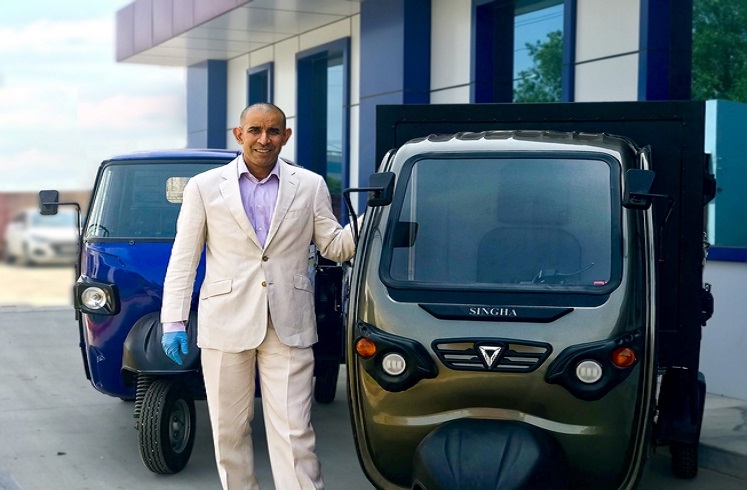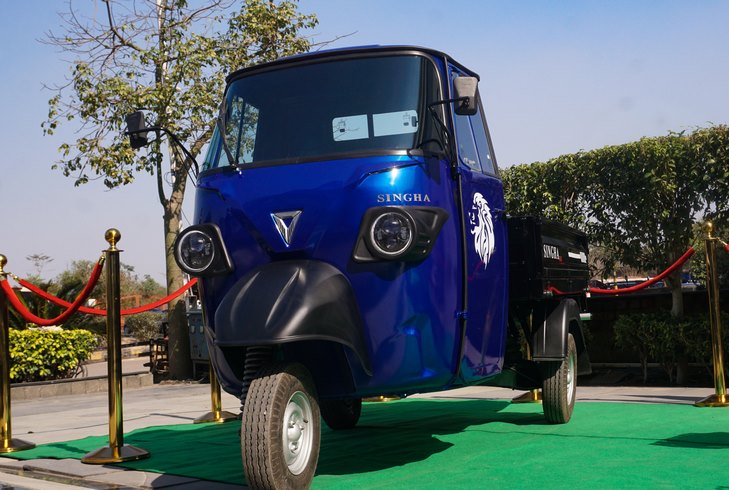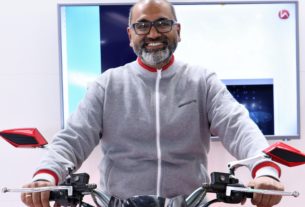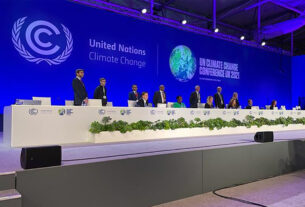Given the fact that the road ahead for the automotive industry lies in the space of electric vehicles, the company has been taking giant steps ahead with a full-fledged team of automotive professionals and the use of latest technologies.

Anglian Omega Group started its industrial journey 50 years ago with an entry into the steel business. From its entity as single steel bright bar rolling mill, Omega Bright Steel has come a long way, becoming a market leader in bright bars, steel beams and other products. It has also ventured into automotive components, manufacturing high-quality engine and powertrain components and assemblies. The group today operates eight manufacturing facilities spread across India with setups in Delhi NCR, Pune and Chennai. This growth has come primarily in the last eight years ever since Uday Narang, the present chairman of the group, began to steer a wide range of business expansion activities.
Having spent more than three decades in the financial world of the US and Europe, Narang returned to India after his father passed away. Since then he has invested in building facilities and acquiring assets all over the country. “We are building the foundation of our new company. The building of the new Anglian Omega Group of the forthcoming decades will be built on this foundation. This will be a company with its roots in technology, diverse products, scale and above all, professional people. It will have the bandwidth of international locations and partners, merging boundaries and operating seamlessly round-the-clock,” Narang states.
Indian Electric Mobility Scenario
Omega Seiki Mobility is the electric vehicles’ business arm of Anglian Omega Group, which it decided to foray into sometime in 2017. The motivation came from the fact that the Indian market is currently dominated by cheap and low-end three-wheeler electric vehicles (EVs). These are mostly imported from China and put on the road for last mile connectivity for transportation of passenger and cargo. The electric vehicle industry is at a nascent stage in India. It is less than 1% of the total vehicle sales but does have the potential to grow to more than 5% in a few years.
At present there are more than 500,000 electric two-wheelers, 2 million three-wheelers and less than 5,000 electric cars on Indian roads. The industry volumes have been fluctuating, mostly dependent on incentives offered by the government. Of these, more than 90% of electric vehicles on Indian roads are low-speed electric scooters with a capacity of less than 25 km per hour. These do not require registration and licenses. Almost all electric scooters run on lead batteries to keep the prices low. However, battery failures and low life of batteries have become major limiting factors for sales besides government subsidies.

“I want to build a Tesla of the East. The new Omega Anglian Group will be futuristic, dynamic and diverse”
Uday Narang, Chairman, Anglian Omega Group
In the meantime, many manufacturers have taken initiatives to install charging stations but with limited success. In the three-wheeler segment, there are a number of e-rickshaw players mushrooming across the country and selling good numbers for last-mile connectivity. These are all low-end vehicles imported from China. “Our motivation came from a desire to replace the cheap, low-quality, low-durability, unsafe vehicles on road – mostly Chinese imports – by reliable, high-quality indigenously made vehicles,” says Dr. Deb Mukherji, Managing Director, Omega Seiki Mobility.
Venturing into EV Space
Omega Seiki Mobility started work on electric vehicles with an in-house research and development team. A technology team was put together comprising experienced professionals from the field of electric mobility. Benchmarking was done with vehicles on the road and specifications and performance criteria were finalised. The customers’ voice was captured regarding vehicle requirements and a gap analysis was done to build a contemporary vehicle. The extensive exercise resulted in deciding the three-wheeler EV product specifications and performance parameters. Prototypes were then built and extensively tested on real road conditions. Some of the vehicles were also deployed with a logistics fleet to get an actual on- road delivery feeling.
All the data was collected and analysed to fine-tune the vehicle’s specs. The company worked with a leading powertrain partner to get the engineering portion worked to perfection. “The powertrain happens to be the most important part of the vehicle other than the battery. It consists of the motor, gears and drives connecting with the wheels. In most cases, manufacturers of EVs pick components off the shelf and engage in assembly work to make a powertrain. This is not right. The entire powertrain must be designed for efficiency and optimised power. This is important because it links up with the battery,” points out Dr. Mukherji.
“An EV needs to be designed around the battery and powertrain. As such, vehicle engineering is important. It’s not just an assembly of parts,” he adds. The company showcased its products at the Auto Expo trade fair in February 2020. The response was very encouraging, in fact even surpassing the company’s own expectations. Most of the buyers from the e-commerce industry were very excited to see the product. Also, retail customers from the passenger e-rickshaw industry sent out feelers in big numbers.
With growing interest and investments in the electric mobility space by e-commerce giants such as Amazon Walmart and even Jio, Omega Seiki Mobility has set its sights on covering the complete EV ecosystem. “Our vision is to become a fully integrated vehicle manufacturer in the EV space with robust technology that is completely indigenously developed. We take pride in our research and development and product innovation,” Narang states. The mobility business will be an extension of the EV business as the company believes in providing value-based services to its customers. This is in a scenario where last mile connectivity is a pain point for most of the e-commerce companies.
Such delivery-based companies find it challenging to handle daily deliveries to retail customers on a regular basis. The multiple challenges include vehicle inefficiencies, high turnaround times, operational issues related to drivers, pilferages, etc. Given such ground realities, Omega Seiki Mobility has developed its business plan around offering a complete mobility solution to its customers. The company has developed an IT platform which works on allocating required cargo space to the customer. The IT software helps decide whether the vehicle would be two, three or four-wheeler depending on the cargo to be delivered.
Technology at Work
The software also optimises the routes of delivery based on traffic and road closures or diversions, etc. One of the critical parts in the development of an EV is the battery system, including cells, lithium metal, binders, separators, electrolytes, anodes and cathodes. The Li-Ion battery needs to be managed well during the entire lifecycle, which many in India do not understand, Dr. Mukherji points out. The battery performance also changes drastically after the specified numbers of charging cycles.
Looking at the Indian market and the maturity of technologies, Lithium Iron Phosphate (LFP) chemistry is preferred by EV manufacturers because of its charging density over the other option of Nickel Magnesium Cobalt (NMC). There is extensive research being done on this and Dr. Mukherji believes that the 1,000 km per charge threshold will be cracked very soon. There is also a lot of debate on the battery system deployed in an EV and Dr. Mukherji is of the opinion that there is merit in both fixed battery as well as swappable battery systems in the Indian market.
“Omega Seiki Mobility believes it is in the right space at the right time with its two, three and four-wheeler products”
Dr. Deb Mukherji, Managing Director, Omega Seiki Mobility
What remains a major issue though is charging infrastructure while the swappable battery system has its own set of challenges such as battery standardisation protocols along with connectors that allow the user to quickly disconnect and replace the discharged battery with a charged one. “The system can be a viable option for the cargo segment once the technology matures as it will take care of the range anxiety and downtime due to battery discharge,” Dr. Mukherji points out.
The Right Partnership
Omega Seiki Mobility has its own battery partner, a large US-based Li-Ion battery manufacturer with operations in India. The MOU to develop and mass produce Li-Ion batteries with this partner – Innolia Energy – is already in place. “This will allow us to make our own energy management system for the vehicles and we will not be dependent on a foreign country-based battery maker. Omega Seiki Mobility will be a complete ecosystem of EV with several partners and strategic collaborators. It’s a model not practiced in India so far. Usually an OEM sets up a vehicle assembly shop and sources parts from suppliers. We have drawn the circle from the other side with an entire supply chain. This is in line with the national vision of creating a self-reliant India,” Narang states.
An Exciting Future
For Omega Seiki Mobility, the foray into electric energy vehicles is packed with excitement. This is because the disruption caused by electric vehicles is going to be profound one. With Tesla becoming the most valuable automotive company, there is little room for doubt that EVs is where the future lies. And India certainly is not going to lag behind. Starting with two and three-wheelers, the transition will soon include personal mobility vehicles like cars and SUVs. The infrastructure of charging and battery swapping would also be in place soon with government support, Dr. Mukherji opines.
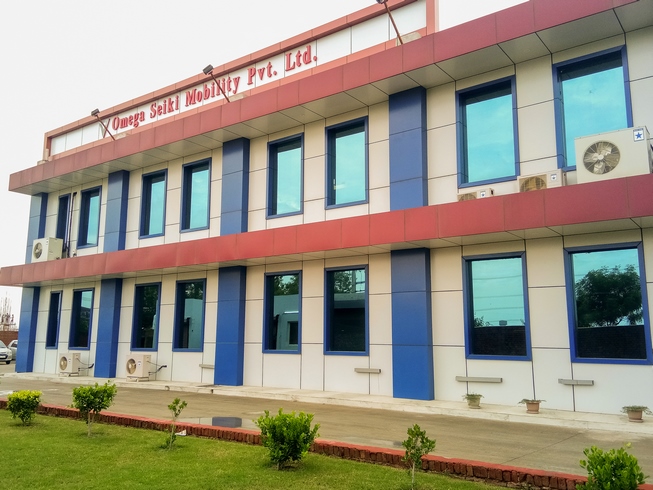
The government has been very clear in its vision of developing an alternate energy economy. With the success of solar and wind energy, the time is now ripe for battery technology. Meanwhile, campaigns such as ‘Make in India’ and the FAME II subsidies are a shot in the arm for the EV industry. The government has already announced a stepwise transition to EV mobility, especially for two and three-wheelers. It is also tightening emission norms for IC engine vehicles. All these are positives for the EV industry.
“The challenges of technology, mileage and charging need to be overcome in the near future for large-scale EV adoption in India. Our company is also looking at export of EV components and vehicles with a presence in the international markets of Southeast Asia, Latin America and Europe. India has got a great chance to capture a share of the global EV components’ business soon, globally estimated at more than USD 500 billion. This would also place India in the global EV market space. The company has a clear focus on technology, supply chain and market for its EVs, these being the key parameters for creating a successful automotive business. Our investment in technology is continuing for new product development, battery production and data analytics,” Narang states.
(This story first appeared as an exclusive cover story in EV Tech News Digital Magazine August 2020 edition)


